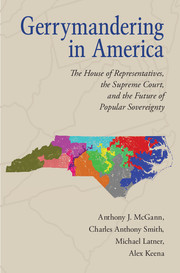 Gerrymandering in America
Gerrymandering in America Book contents
- Frontmatter
- Contents
- 1 The Unnoticed Revolution
- 2 The Jurisprudence of Districting
- 3 Measuring Partisan Bias
- 4 Geographic Explanations for Partisan Bias
- 5 Political Explanations of Partisan Bias
- 6 Constitutional Implications of Vieth: The Revenge of the Anti-Federalists
- 7 Answering Justice Scalia's Challenge to Equality: Does Equal
- 8 Conclusion: Vieth, Majority Rule, and One Person, One Vote
- Bibliography
- Index
4 - Geographic Explanations for Partisan Bias
Published online by Cambridge University Press: 05 March 2016
- Frontmatter
- Contents
- 1 The Unnoticed Revolution
- 2 The Jurisprudence of Districting
- 3 Measuring Partisan Bias
- 4 Geographic Explanations for Partisan Bias
- 5 Political Explanations of Partisan Bias
- 6 Constitutional Implications of Vieth: The Revenge of the Anti-Federalists
- 7 Answering Justice Scalia's Challenge to Equality: Does Equal
- 8 Conclusion: Vieth, Majority Rule, and One Person, One Vote
- Bibliography
- Index
Summary
In the previous chapter, we found considerable evidence of partisan bias in the districting plans in many states that, when aggregated over the entire nation, gave the Republican Party a considerable advantage. Furthermore, we found that the level of bias in the 2010 districting round was approximately three times that in the 2000 round. However, it could be argued that this bias is not the result of deliberate partisan gerrymandering, but rather the inevitable results of geographical or demographic factors. For example, it could be argued that the observed bias is a result of the fact that Democratic voters tend to be concentrated in urban areas. This leads to Democratic votes being inefficiently distributed without the need for conscious gerrymandering. In this chapter, we consider the plausibility of such explanations.
There are a number of ways partisan bias could be explained without the need for deliberate gerrymandering. First, as we just noted, it could result from the fact that Democratic voters tend to be concentrated in urban areas. As a result, the Democrats win districts in these areas by far greater margins than they need, leaving the Republicans to win a greater number of nonurban districts by smaller margins. Thus the kind of bias we described in the previous chapter comes about as a result of where people live and would be hard to avoid regardless of who drew the boundaries. Alternatively, it has been suggested that the desire to provide descriptive representation for minorities and the need to draw majority-minority districts to comply with the Voting Rights Act might reinforce the concentration of Democratic voters in overwhelmingly Democratic districts. Finally, increased bias might result from the fact that the technology for districting (in particular geographic information systems) has improved. This explanation is slightly different in that it does not claim that bias is not the result of partisan motives. However, it argues that the increased bias we observe is not the result of a change in the motives of districting authorities or the constraints they face, but rather a result of the fact that they are more able to gerrymander accurately. That is, the motives have not changed, but the tools available to fulfill those motives have improved.
- Type
- Chapter
- Information
- Gerrymandering in AmericaThe House of Representatives, the Supreme Court, and the Future of Popular Sovereignty, pp. 97 - 145Publisher: Cambridge University PressPrint publication year: 2016


